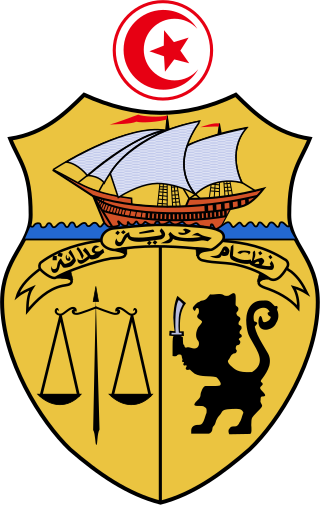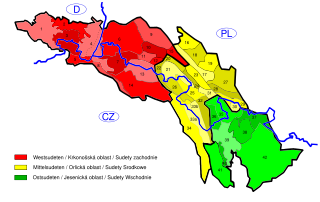Related Research Articles

Tunisia is divided into 24 governorates. This term in Arabic can also be translated as province.

Carcharhinus is the type genus of the family Carcharhinidae, the requiem sharks. One of 12 genera in its family, it contains over half of the species therein. It contains 35 extant and eight extinct species to date, with likely more species yet to be described.

The Eastern Sudetes are the eastern part of the Sudetes mountains on the border of the Czech Republic and Poland. They stretch from the Kłodzko Valley and the Eastern Neisse River in the west down to the Moravian Gate in the east, leading to the Outer Western Carpathians.
Anatomites is an extinct genus of cephalopod belonging to the Ammonite subclass.
Anaxenaspis is an extinct genus of cephalopod belonging to the Ammonite subclass.
Anagymnotoceras is an extinct genus of cephalopods belonging to the Ammonite subclass.

Ischyrhiza is an extinct genus of sclerorhynchoid ray from the Late Cretaceous (Cenomanian-Maastrichtian).

Curtis Gates Lloyd was an American mycologist known for both his research on the gasteroid and polypore fungi, as well as his controversial views on naming conventions in taxonomy. He had a herbarium with about 60,000 fungal specimens, and described over a thousand new species of fungi. Along with his two brothers John Uri Lloyd and Nelson Ashley Lloyd, he founded the Lloyd Library and Museum in Cincinnati.
The Huayquerian age is a period of geologic time within the Late Miocene epoch of the Neogene, used more specifically within the SALMA classification. It follows the Chasicoan and precedes the Montehermosan age.
Pillararhynchus is an extinct genus of prehistoric sarcopterygians or lobe-finned fish.
Orlovichthys is an extinct genus of prehistoric sarcopterygians or lobe-finned fish. Fossil evidence was found in Russia, and is from the Late Devonian period.
Tranodis is an extinct genus of prehistoric sarcopterygians or lobe-finned fish. It was a lungfish from the Upper Mississippian of North America.

Chelonoidis is a genus of turtles in the tortoise family erected by Leopold Fitzinger in 1835. They are found in South America and the Galápagos Islands, and formerly had a wide distribution in the West Indies.
Wurmiella is an extinct conodont genus.

Eczematolepis is an extinct genus of ptyctodontidan from the Milwaukee Formation of Wisconsin. Three species are known: E. fragilis, E. pustulosus and E. telleri. It was originally classified as the genus Acantholepis but that name was preoccupied.
Equus niobrarensis is an extinct species of Equus, the genus that includes the horse. E. niobrarensis may be synonymous with Equus scotti. It was "stout-legged" and belonged to the "big horses" category as defined by M. C. Winans. The skull of the horse was noted as being broader than Equus caballus.
Kaikaifilusaurus is an extinct genus of rhynchocephalians in the family Sphenodontidae from the Late Cretaceous of South America. Fossils of the genus were found in Cenomanian sediments of the Candeleros Formation and Turonian layers of the Huincul Formation, both of the Neuquén Basin and the Albian strata of the Cerro Barcino Formation in the Cañadón Asfalto Basin, all in Patagonia, Argentina. The genus contains two species, K. minimus and the type species K. calvoi.
Microcnemus is an extinct genus of lizard-like early archosauromorph reptiles from the Protorosauridae. Members of the genus lived during the Early Triassic period in Russia. Once believed to have been an ancestor to lizards, Microcnemus is now known to be one of the oldest members of the lineage that would eventually lead to archosaurs such as crocodilians and dinosaurs. The type species, M. efremovi, was named in 1940 by the German palaeontologist Friedrich von Huene.
The FIG Parkour World Championships are a parkour competition organized by the International Gymnastics Federation (FIG). Originally scheduled for 2020 and delayed due to the COVID-19 pandemic, the inaugural edition was held from October 14, 2022, in Tokyo, Japan.
References
- ↑ "Fossilworks: Anaflemingites". fossilworks.org. Retrieved 17 December 2021.
- ↑ "Fig. 72. Anaflemingites hochulii Brayard and Bucher, 2008, from..." ResearchGate. Retrieved 2019-03-14.
- ↑ "Fig. 13.6 Some characteristic ammonoids of the middle Smithian (Early..." ResearchGate. Retrieved 2019-03-14.